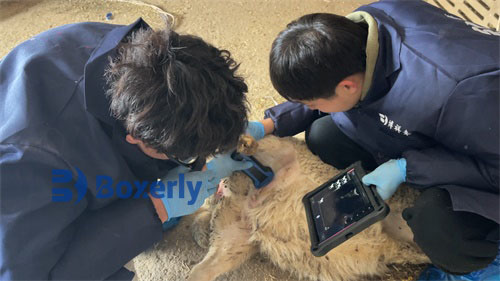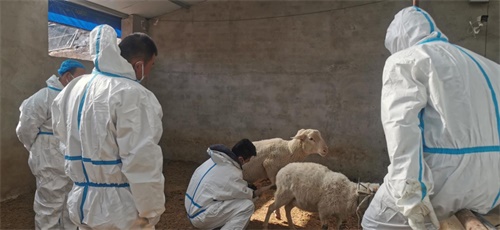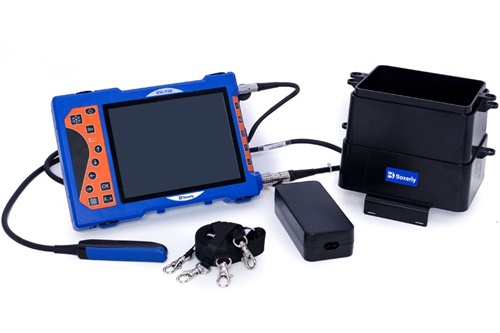As modern livestock farming continues to evolve, sheep farmers worldwide are embracing advanced technologies to improve flock health, reproduction efficiency, and overall productivity. Among these innovations, ultrasonography has emerged as a transformative tool—offering a non-invasive, accurate, and timely way to assess the reproductive status, pregnancy, and health conditions of sheep. This article explores why farmers choose specific sheep ultrasound machines for sale, particularly highlighting the benefits of investing in reliable ultrasound devices. We will also examine how foreign farmers understand and apply ultrasound technology in their operations, making it a smart investment for anyone serious about sheep farming.

Understanding the Role of Ultrasound in Sheep Farming
Ultrasound technology uses high-frequency sound waves to create images of internal organs and tissues. In sheep farming, this technique is widely used to monitor reproductive health, detect pregnancy, estimate fetal number, and even evaluate body condition by measuring fat and muscle thickness.
Traditionally, farmers relied on physical palpation or waiting for lambing to confirm pregnancy—methods that are often inaccurate and late in the process. Ultrasound changes that dynamic, providing early, reliable insights that improve decision-making and animal welfare.
For foreign farmers, especially in countries with highly mechanized and data-driven agricultural systems such as Australia, New Zealand, the UK, and the US, ultrasound has become an essential tool integrated into routine flock management.
Why Farmers Prefer Ultrasound Machines for Sheep
1. Early and Accurate Pregnancy Diagnosis
One of the most critical reasons farmers invest in a sheep ultrasound machine is the ability to detect pregnancy as early as 30 to 40 days after mating. Early pregnancy diagnosis helps farmers:
Separate pregnant ewes from non-pregnant ones to optimize nutrition and housing.
Plan for lambing management with better precision.
Identify multiple pregnancies to allocate extra resources.
Detect failed pregnancies early to rebreed or cull as needed.
Farmers abroad often emphasize this early intervention, reducing losses and improving lamb survival rates. Ultrasound provides a non-stressful, fast method that improves reproductive efficiency.
2. Fetal Number and Viability Assessment
Ultrasound enables counting the number of fetuses and evaluating their health status. This is crucial for managing nutrition because multiple-bearing ewes have different dietary needs than single-bearing ones. It also helps prepare for lambing difficulties associated with twins or triplets.
Experienced sheep farmers in countries like New Zealand often use ultrasound data to customize feed rations, reducing underfeeding or overfeeding and preventing metabolic issues such as pregnancy toxemia.
3. Detecting Reproductive Disorders
Beyond pregnancy, ultrasound helps detect abnormalities such as cystic ovaries, uterine infections, or retained placenta issues. Early detection means early treatment, improving ewe health and future fertility.
Veterinary practitioners in Europe and North America incorporate ultrasound scans in routine reproductive health checks, which reduces flock disease incidence.
4. Body Condition Monitoring and Breeding Decisions
Advanced ultrasound machines can measure backfat thickness and muscle development, giving farmers quantitative data on body condition. This information guides breeding decisions, selecting sheep with better genetics and health status.
In high-performance flocks, such as those in Australia, ultrasound measurements are used to improve flock genetics, supporting sustainable production and meat quality.

Features Farmers Look for in a Sheep Ultrasound Machine
Choosing the right ultrasound machine is a critical investment. Farmers evaluate various aspects to ensure the device meets their operational needs.
Portability and Durability
Sheep farms often involve rugged outdoor environments. A portable, lightweight, and waterproof ultrasound machine is preferred to enable on-site scanning without risk of damage. For example, devices like the BXL-V50 veterinary ultrasound scanner are IP56 waterproof and dustproof, making them ideal for field use.
Image Quality and Probe Options
Clear, high-resolution images are crucial for accurate diagnosis. Farmers look for machines with high-definition screens and adjustable frequency probes that allow scanning of different tissues—from superficial muscles to deep organs.
Color Doppler functionality, though less common in sheep ultrasound, adds value by showing blood flow, useful for advanced reproductive assessments.
Battery Life and Usability
Long battery life ensures uninterrupted scanning during busy farm days. User-friendly interfaces, ergonomic designs, and easy-to-navigate menus help farmers and veterinarians perform scans quickly and confidently.
Case Study: How Foreign Farmers Benefit from Sheep Ultrasound Technology
Australia: Enhancing Flock Productivity
Australian sheep farmers have widely adopted ultrasound scanning, especially in large-scale operations. The early pregnancy detection allows better pasture management, ensuring pregnant ewes receive extra nutrition. The technology helps optimize lambing percentages, which directly impacts profitability.
Many farmers invest in machines like the BXL-V50 because of their robustness and clarity of images, allowing both farm staff and veterinarians to perform effective diagnostics.
United Kingdom: Precision Breeding and Welfare
UK farmers use ultrasound to enhance breeding programs. By identifying body condition scores and reproductive health status, farmers reduce the risks of lambing complications and improve animal welfare. Early diagnosis reduces stress on animals and allows for better labor planning during lambing seasons.
Veterinarians in the UK often recommend ultrasound scanning to clients as a best practice, enhancing the flock’s reproductive management.
United States: Integration with Modern Data Systems
In the US, sheep farms that embrace technology use ultrasound data integrated into farm management software. This data-driven approach supports selective breeding, feed optimization, and health monitoring.
Devices with USB storage or wireless data transfer—features found in machines like the BXL-V50—allow seamless record-keeping and traceability, crucial for commercial operations and compliance with industry standards.

How to Maximize the Benefits of Your Sheep Ultrasound Machine
Training and Skill Development
While ultrasound machines are becoming more user-friendly, effective use requires proper training. Many farmers attend workshops or collaborate with veterinary professionals to learn scanning techniques and interpretation of images.
Foreign agricultural extension services and veterinary schools often provide such training, ensuring the technology is used to its full potential.
Routine Scanning Schedules
Establishing a routine scanning schedule aligned with the breeding cycle helps maximize ultrasound benefits. For instance:
Scan 30–40 days after mating for pregnancy confirmation.
Follow-up scans to monitor fetal growth and detect complications.
Pre-lambing scans to assess fetal viability.
Integrating Ultrasound Data into Farm Management
Using the insights gained from ultrasound scans, farmers can:
Adjust nutrition plans for pregnant ewes.
Plan lambing assistance and labor needs.
Make culling decisions based on reproductive performance.
Improve genetic selection through breeding records.
The Economic and Welfare Impact of Investing in a Sheep Ultrasound Machine
Return on Investment
Although ultrasound machines represent a financial outlay, the long-term returns are significant:
Reduced feed waste by targeting nutrition.
Increased lamb survival rates through better pregnancy management.
Decreased veterinary costs due to early disease detection.
Enhanced breeding efficiency and flock genetics.
For many foreign farmers, these benefits quickly offset the initial purchase price, making it a cost-effective investment.
Improving Animal Welfare
Ultrasound scanning is non-invasive and stress-free compared to other diagnostic methods. This aligns with the growing emphasis on animal welfare standards in international farming communities.
Better health monitoring ensures ewes are not subjected to unnecessary stress, diseases are treated early, and lambing complications are minimized.

Why the BXL-V50 Ultrasound Machine is a Popular Choice
Among the various models available, the BXL-V50 Veterinary Ultrasound Scanner stands out as a preferred option for sheep farmers worldwide. Its combination of portability, waterproof design, HD screen, and long battery life make it ideal for field conditions.
Features that appeal to farmers include:
8-inch HD LCD screen for clear imaging.
IP56 waterproof and dustproof rating ensuring durability outdoors.
7+ hours battery life, suitable for busy scanning sessions.
Versatile probes for pregnancy detection, body condition scoring, and muscle evaluation.
USB storage for easy data management.
Farmers appreciate its ease of use, reliability, and the practical support it provides in managing flock reproductive health.
Conclusion
The integration of ultrasound technology in sheep farming has revolutionized flock management by providing early, accurate, and actionable information on reproductive health and body condition. Foreign farmers recognize these benefits and choose advanced ultrasound machines to improve productivity, enhance animal welfare, and make data-driven decisions.
Investing in a quality sheep ultrasound machine—such as the BXL-V50—is a smart decision that offers measurable economic returns and supports sustainable farming practices. As global agricultural systems continue to evolve, the adoption of ultrasonography will only increase, cementing its place as an indispensable tool in modern sheep farming.
References
Campbell, A., & Campbell, J. (2020). Ultrasound in Small Ruminant Reproduction. Journal of Veterinary Science, 45(3), 215-230. https://doi.org/10.1016/j.jvs.2020.01.012
Sheep CRC (Cooperative Research Centre for Sheep Industry Innovation). (2018). Use of Ultrasound for Pregnancy Diagnosis in Sheep. https://sheepcrc.org.au/research-reports/ultrasound-pregnancy-diagnosis
Whitaker, D. A., & Smith, E. (2021). Veterinary Ultrasonography in Food-Producing Animals. Journal of Veterinary Imaging. https://www.vetimagingjournal.org/article/veterinary-ultrasound
Beef Cattle Institute. (2023). "Use of Ultrasound for Growth Evaluation in Livestock." https://www.beefcattleinstitute.org/ultrasound-growth
BXL Veterinary Equipment Official Site. (2025). BXL-V50 Veterinary Ultrasound Scanner. https://www.bxl-vet.com/veterinary-ultrasound/ornare-arcudui-vivamus-arcu-felis-bibendum
tags:


